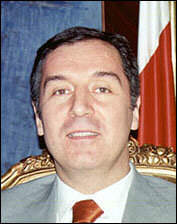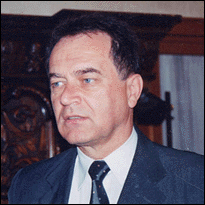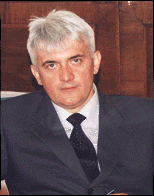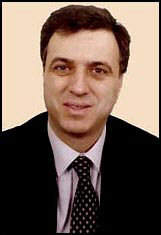 A NEW BEGINNING A NEW BEGINNING |
After the break-up of Yugoslavia in 1992, where the Republic of Montenegro used to be one of the six constituent republics, Montenegro decided to build the Federal Republic of Yugoslavia (FRY) along with the Republic of Serbia. Yet the start-up of war in other parts of former Yugoslavia (in Croatia and Bosnia) brought this small republic, along with Serbia, into isolation and economic destruction.
This isolationist period, followed by international sanctions against FRY, almost destroyed the Montenegrin economy. Its GDP dropped from $2,400 per capita in 1989 to almost $600 in 1995. As a result, during the mid-1990s, Montenegro's economy was in dire straits: high unemployment, low living standards and a flourishing grey economy devastated the country.
 Political change Political change |
The split between Montenegro and Serbia, and the start of a new policy took form after Presidential elections were organized in October 1997. At this time, Montenegro was still led by Momir Bulatovic, the figurehead of former Serbian President Slobodan Milosevic. Then things changed.
"At that moment, Montenegro was choosing one of two possible directions" recalls Milo Djukanovic, President of the Republic of Montenegro. "One direction led back to a false history and mythomania, and led to a blind following of Milosevic's policy, which is something that Mr. Bulatovic persistently stood for. The other direction led towards something unknown for us - toward reforms, democracy and integration into European society".

Montenegrins chose the second option, led by President Djukanovic, who was at that time Prime Minister. Part of this change in government also meant defiance of Milosevic, and the repatriation of many institutions from federal onto republican level.
Parliamentary elections then took place in May 1998 - they were the first elections after eight years of authoritarian communism, and also gave birth to the first coalition government in Montenegro, taking power away from the party of Momir Bulatovic.
Then, the government of Montenegro made a courageous move after the 1998 elections. In a direct challenge to the authority of former President Milosevic, it repatriated all of its institutions from the Federal government. The Central Bank, the Ministry of Finance, the Ministry of Economy - you name it, they were all repatriated back to Podgorica, the capital of Montenegro.
During this time, the international community strongly supported Montenegro with financial aid, in order to gain an ally and help Montenegro keep its independence from Milosevic.
It is true that the government of Montenegro not only maintained peace in the Republic, but helped NATO as an ally against the suspected war criminal and former President of Serbia, Slobodan Milosevic.
"Political stability is crucial for the arrival of foreign investors to a country and region" notes Djukanovic. "In fact, we have demonstrated this commitment through our success as the only state of the former Yugoslavia that has not had a war in the past decade."
 Reforms begin Reforms begin |
In 1999, Montenegro went even further in its reforms by ridding itself of the Yugoslav Dinar, the local currency, and adopting the German Deutsch Mark instead.

"The adoption of our own monetary policy was a strong move towards the independence of Montenegro in its relations with the Belgrade regime and policy" says Branko Lukovac, Minister of Foreign Affairs.

"It was the impulse for the reforms to begin", adds the Governor of the Central Bank, Ljubisa Krgovic. | Indeed, the new Montenegro government led a reform movement in all areas of the economy, drafting and adopting new legislation in monetary policy, foreign investment, fiscal control and tax collection.
In 4 years the country has changed completely. This is partly thanks to Montenegro's small and relatively independent system, which promises to quickly push economic growth into a new phase of development. "The size of the country is our potential advantage" suggests Djukanovic.
In fact, things moved so quickly that Montenegro adopted an entirely different set of laws, and investors doing business in FRY had to deal with two governments and two sets of legislation.
The international community is now faced with a country that needs to co-exist, but that has set up two different systems within one federation.
 Negotiations with Serbia Negotiations with Serbia |
After political changes in Yugoslavia following the overthrow of former President Milosevic, Montenegro decided to reopen negotiations with Serbia.
Recently, this new basis for relations was re-defined thanks to an agreement brokered by the European Union. On March 14th Serbia and Montenegro have signed an historic accord to re-name the Yugoslav federation: "Serbia and Montenegro", and to formalise the independence of both republics even though they will continue to cooperate on foreign and defence policy.
"This is an extraordinary step forward in terms of stabilising the region," said Javier Solana, EU foreign policy chief, to the BBC World Service. The agreement will not only support economic development in the Baltic region, but some say that the compromise has paved the way for EU membership of both republics.

"Montenegro is pursuing its path towards international and trans-Atlantic integration," says Filip Vujanovic, Prime Minister of Montenegro. "I believe that any serious state official will admit that economic systems of Serbia and Montenegro are completely different and cannot be merged into one, because our economic environment, our resources and our development projects are completely different".
"Our 9 year-old experience as a two-member federation has proceeded to be unproductive" says President Djukanovic. "This is mainly due to the serious structural defect of our federation. That defect lies in the fact that Serbia is 18 times larger than Montenegro, and that it has insufficient sensitivity towards our needs and problems".
Montenegro is following the prescription of the Badinter commission of 1991, which states that each of the former Yugoslavia republics has the right to achieve, within existing borders, a legal status according to international law. Since four of those republics have used this right, Montenegro says that now is time for Serbia and Montenegro to do it.
Djukanovic emphasizes: "the solution to the problem between Serbia and Montenegro is different to the solutions previously used in ex-Yugoslavia, since we do not have any controversial border issue. Montenegro does not claim even a footstep of Serbia, and I believe that this is the case with Serbia as well. So, we have good references to solve this problem in civilised, democratic and non-violent manner".
"We need to improve our relations and bring them to a new, solid basis in order to portray a positive example" says Foreign Minister, Lukovac. "This includes building a mutual coexistence, recognizing our differences and creating a new basis for relations".
Meanwhile, President Djukanovic has been lobbying to develop a consensus on the issue. "Our suggestion is to resolve the crisis in a European and peaceful manner," he says, "to accomplish an agreement between Serbia and Montenegro, to take care of our own homes, and to find, in accordance to general and regional policy, a place for our homes under the European sun". |

